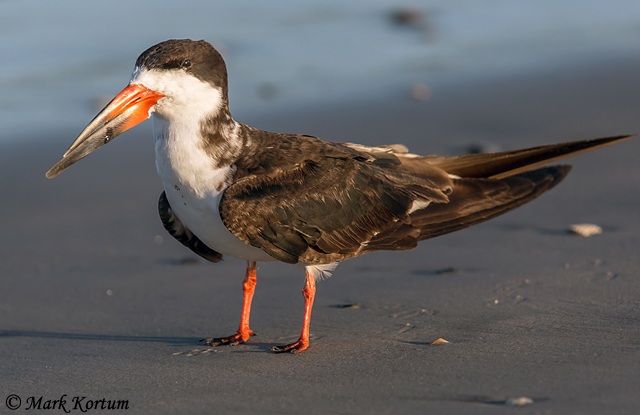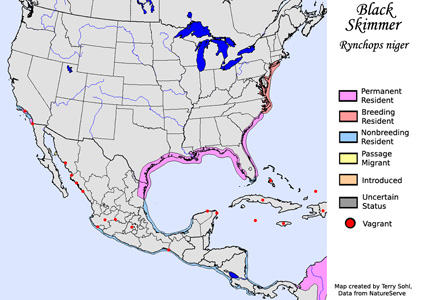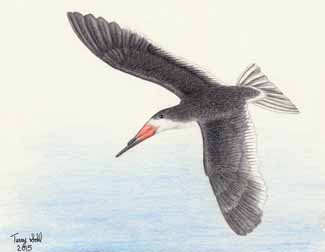Black Skimmer
Rynchops niger
| Length: 18 inches | Wingspan: 44 inches | Seasonality: Non-resident in South Dakota |
| ID Keys: Distinctive. Massive orange and black bill with large lower mandible, black upperparts, white underparts. | ||
 The
Black Skimmer is an unmistakable bird of sandy beaches of the Gulf and
Atlantic coasts of the United States. With their outsized bill with a
massive lower mandible, the Black Skimmer is best known for their unique
foraging technique. They fly low along the surface of the water,
slicing through the water with their lower mandible. They feed by
touch, and the bill snaps shut when prey is felt. In recent decades,
Black Skimmers have also begun to nest on the coast of far southern
California, and inland around the Salton Sea. They are also found in
South America, where they not only inhabit sandy areas along the coast, but
also can be found along sandy areas far inland along South America's large
river systems.
The
Black Skimmer is an unmistakable bird of sandy beaches of the Gulf and
Atlantic coasts of the United States. With their outsized bill with a
massive lower mandible, the Black Skimmer is best known for their unique
foraging technique. They fly low along the surface of the water,
slicing through the water with their lower mandible. They feed by
touch, and the bill snaps shut when prey is felt. In recent decades,
Black Skimmers have also begun to nest on the coast of far southern
California, and inland around the Salton Sea. They are also found in
South America, where they not only inhabit sandy areas along the coast, but
also can be found along sandy areas far inland along South America's large
river systems.
Habitat: Found on sandy beaches and islands during the summer nesting season. At other seasons, they tend to be found around calmer, near-shore waters, as calmer waters are more suited for their unique feeding technique.
Diet: Feeds mostly on fish. They will also sometimes eat small crustaceans or other small invertebrates.
Behavior: Forages by flying low over the water's surface with their lower mandible slicing through the water. They will often feed at night or near sunset, when fish may be closer to the surface.
Nesting: The nest of a Black Skimmer is a shallow depression in the sand, usually on a sandy beach. The female lays between 3 and 6 eggs, and both parents help to incubate them. When the eggs hatch, both parents feed the young, by regurgitation of fish. The young fledge after about 25 days.
Interactive eBird Map: Click to access an interactive eBird map of Black Skimmer sightings
Song: The typical call of a Black Skimmer is a soft yelping yip.
Migration: Considered a permanent resident in warmer parts of its range, including along the Gulf Coast and southern Atlantic Coast in North America. Birds along the Mid-Atlantic coast are only summer residents.
Similar Species: Distinctive, not likely to be confused with another species if seen well.
Conservation Status: Populations appear to be decreasing. However, they are still found over a wide geographic area, and are common in some locations. The IUCN lists the Black Skimmer as a species of "Least Concern".
Further Information: 1) BirdLife International - Black Skimmer
2) Audubon - Black Skimmer
3) New Jersey Fish and Wildlife - Black Skimmer
Photo Information: Photo taken by Mark Kortum - October 28th, 2012 - Jacksonville Beach in Florida - Photo licensed under Creative Commons Attribution NonCommercial NoDerivs 2.0 Generic License.
| Click below for a higher-resolution map |
 |
| South Dakota Status: Non-resident in South Dakota |


